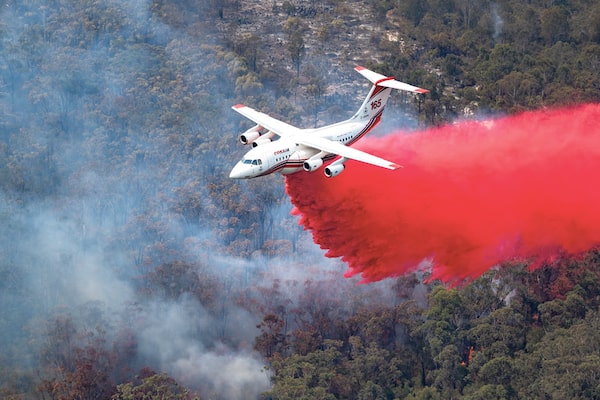
Conair’s Avro RJ85 AT is at the forefront of technology advances in aerial firefighting.NED DAWSON
At a time when much of the aviation industry in Canada is in turmoil, with companies facing an uncertain future as a result of the global pandemic, one Canadian company stands strong, investing in new technologies, training and aircraft to maintain its position as a world leader in aerial firefighting.
Established over 50 years ago, Conair has grown from a single bi-wing, open cockpit plane to a fleet of over 70 aircraft, the largest private aerial firefighting operator in the world. And despite the economic downturn, the company is looking to grow, building more aerial firefighting aircraft in Canada, including the newest airtanker, the Canadian-made de Havilland Q400AT. With a reputation for performance, reliability and value, Conair plans to expand its global operations, partnering with governments around the world to support their forest fire suppression efforts.
Conair was one of the first in Canada to adapt aerial agricultural sprayers into fire retardant dropping planes more than five decades ago. That first initiative sparked a unique partnership between the company and the British Columbia provincial government, with each working together to combat a common threat. Unlike the government, constrained by a lack of resources, the privately owned company had the freedom to invest in research and development.
The Alberta government followed suit shortly after, forging a similar partnership with Conair as British Columbia had done. These proactive, long-term relationships were critical to Conair’s success over the years. The multi-year contracts with the provincial governments meant the company could invest in larger fleets, install innovative systems, train expert teams and employ economies of scale, benefiting both parties. This enabled Conair to not only expand across Canada, supporting both provincial and territorial governments, but also across borders, fostering the company’s expansion into France, Australia and the United States.
Now looking towards the future, Conair’s entrepreneurial spirit is pushing them to be better, investigating new opportunities to tackle new challenges. One challenge the industry faces as a whole is the need to replace aging aircraft, many decades old and at risk of obsolescence. That challenge requires significant, long-term investment.
“The challenge for the aerial firefighting industry is to keep pace with and take advantage of technology innovations.” says Brian Simpson, wildfire consultant and former executive director of B.C.’s Wildfire Management Branch, “Any advances that improve response time, communication and reliability of the aircraft are crucial.”
Jeff Berry, Conair’s director of business development, agrees.
“Aerial firefighting aircraft are fire trucks in the sky. We cannot risk having planes grounded. That is why Conair is investing in new, sustainable aircraft that can fly for decades into the future,” says Mr. Berry. “In addition to newer aircraft, such as the Q400AT, we need to provide a diverse fleet of aircraft, capable of supporting a wide variety of wildfires in a wide variety of terrain, from land-based airtankers through to amphibious Viking CL-415s and Air Tractor Fire Bosses. This strategy keeps us ready to respond at a moment’s notice, to any fire, supporting our firefighters on the ground.”
Michael Benson, manager, Wildfire Operations in the Edmonton office of FPInnovations, a non-profit research and technology development organization serving the forestry sector, adds that wildfires have become increasingly complex, particularly at the urban interface where lives and property are often at stake.
“The investments aerial firefighting companies are making in aircraft and advanced technology are vitally important to tackling these fires quickly and with as little damage as possible,” he says.
He points out that the funding challenges faced by many government agencies mean it’s often up to the private sector to make big investments in modern aerial firefighting capabilities, including aircraft and crew training.
Mr. Berry says that’s precisely what Conair aims to do.
“We take a proactive approach. In addition to expanding our aircraft fleet, we are creating the largest Training + Tactics Centre in the world, offering pilots the ability to train in simulators that provide true-to-life aerial firefighting scenarios,” he says. “Conair’s goal is to provide the most effective aerial firefighting missions with the safest outcomes for the best value.”
The unprecedented number of wildfires that have devastated large parts of the world in recent years highlight the crucial role aerospace is playing in efforts to save lives and property. With the global demand for aircraft to help fight fires increasing, there is pressure on companies like Conair to have aircraft, crews and support services available at a moment’s notice – and to make sure they remain operational throughout their mission.
For more information, visit https://conair.ca/
Produced by Randall Anthony Communications. The Globe’s editorial department was not involved in its creation.